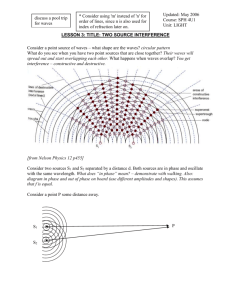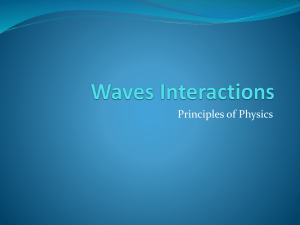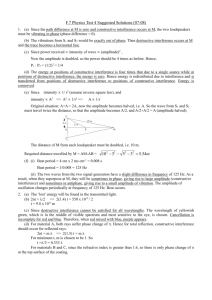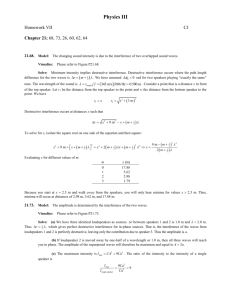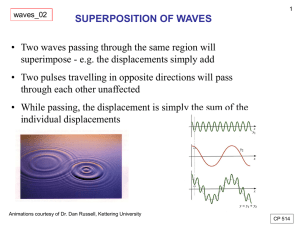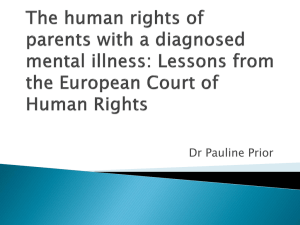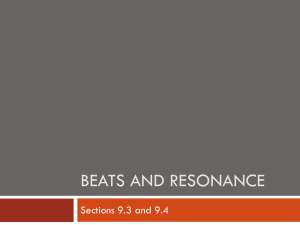Goal: To understand the basics of interference
advertisement
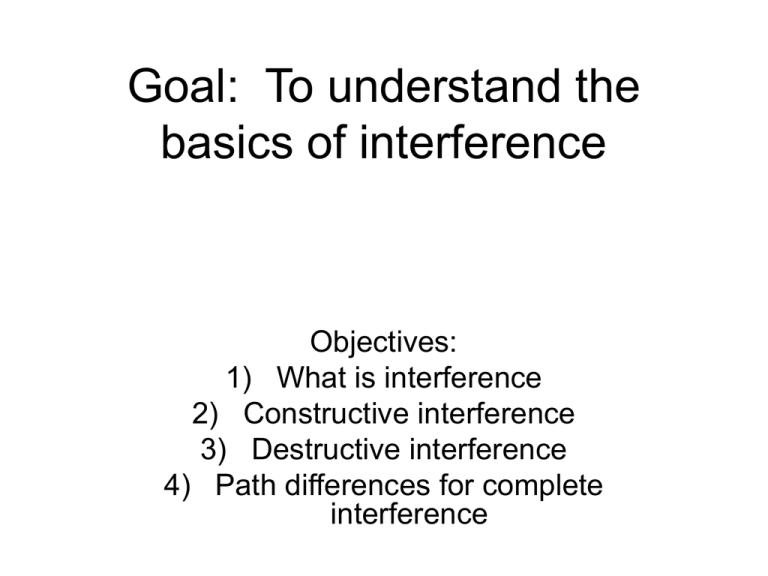
Goal: To understand the basics of interference Objectives: 1) What is interference 2) Constructive interference 3) Destructive interference 4) Path differences for complete interference What is interference? • Interference is when a defender attacks a receiver before the ball reaches him. • Err wait sorry wrong sport. • Interference is when 2 waves reach the same spot. • These waves will add together – thus interfering with one another. • Depending on how they interfere this can be a good thing or a BAD thing. Constructive interference • If two waves land on top of each other they can add together if their positives and negatives match up (this is called “in phase”). • If the waves peak at exactly the same time, they will add together making a bigger wave. • This is called constructive interference. Destructive interference • If two waves land on top of each other they can subtract if their positives meet with the others negatives (this is called “out of phase”). • If the waves peak at exactly opposite times, they will subtract making a smaller wave. • If the waves have the same amplitude (or strength) then they can COMPLETELY cancel each other out! • This is called destructive interference. Uses? • Think of 1 possible GOOD use for both constructive and destructive interferrence. Path differences for complete interference • If a source emits photons of a specific wavelength in 2 different directions it is possible (due to reflection or something else) that those two paths will cross. • When they cross you can possibly get interference. • However, what type of interference will you get? Depends • The interference type depends on the difference in distances that each wave has to take. • Lets say a radio wave is 1 m long. • What must be true about the difference in distances if two paths meeting produce constructive interference? • What about for destructive interference? Depends • The interference type depends on the difference in distances that each wave has to take. • Lets say a radio wave is 1 m long. • What must be true about the difference in distances if two paths meeting produce constructive interference? • The difference in paths has to be equal to an exact number (i.e. an integer) of wavelengths. • So, 1 m, 2 m, 17m, ect, but not 1.1 m. • What about for destructive interference? • Has to be a difference of half waves – such as 0.5 m, 1.5m, 2.5 m, 175.5 m, but not 0.4 m, or 0.6 m, and def not 3.0 m. Example • This is from HW 10 • A radio tower emits radio waves with a wavelength of 400 m. • These waves travel 15.3 km to a radio receiver. • One path is directly to the receiver. • The 2nd path goes past the receiver and reflects of the hills behind the receiver and come back. • If no the reflection causes no phase change in the waves then what is the smallest distance away the hills can be from the receiver if total destructive interference is caused? Example • A radio tower emits radio waves with a wavelength of 400 m. • These waves travel 15.3 km to a radio receiver. • One path is directly to the receiver. • The 2nd path goes past the receiver and reflects of the hills behind the receiver and come back. • If no the reflection causes no phase change in the waves then what is the smallest distance away the hills can be from the receiver if total destructive interference is caused? • The path difference has to be a half wave, or 200 m. • But, since the radio waves have to go to the hill and back the path difference is twice the distance to the hills. • So, the distance to the hills is 100 m. Conclusion • We quickly looked at what constructive and destructive interferences are. • We saw to get them we needed to add waves either in phase or out of phase. • If they all come from the same place then we need to have the path differences be some number of wavelengths for constructive interference, or some half number for destructive.
